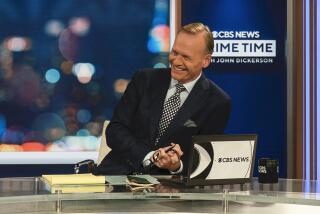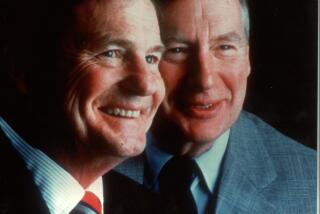The Minds Behind CBS News’ Golden Age
- Share via
The second World War unleashed a tremendous surge of energy in this country. Fighting for national survival, Americans transformed the nation in a few short years.
One of the inventions that sprang from the turmoil of war was broadcast news. Broadcast news meant the Columbia Broadcasting System, and CBS meant Edward R. Murrow and the young people, nearly all men, he recruited to tell over the radio from Europe the approach of war and America’s plunge into it.
In this brisk and vivid book, Stanley Cloud and Lynne Olson, both experienced journalists, tell the story of the rapid rise of CBS news, its initial brilliance, and its all too rapid postwar slide into mediocrity.
No one who listened to him can ever forget Murrow’s nightly introduction to his program: “This . . . is London.”
We were really going to hear from London, and, as the war spread, from CBS correspondents all over Europe.
Murrow went to Europe in 1937 at the age of 29 to build a CBS presence there. The first person he hired for the network was William L. Shirer, an experienced newspaper foreign correspondent.
“The Murrow Boys” tells the stories of these two and the others Murrow hired: Cecil Brown, Winston Burdett, Charles Collingwood, William Downs, Thomas Grandin, Richard C. Hottelet, Larry LeSueur, Eric Sevareid, Howard K. Smith and the lone woman, Mary Marvin Breckinridge.
“We all had big egos,” Hottelet said. “We all wanted to be the star.
“The only one who could have managed this team of horses with any success was Ed Murrow.”
It comes clear in the book that Murrow didn’t manage much. He hired the people and set them loose.
“There was great feeling about it, a sense of intoxication,” Hottelet said. “It was your job, your voice, your report.”
Cloud and Olson justly point out that the reporters’ freedom was remarkable.
“We had no budget,” Murrow said. “Nobody gave orders. New York asked us only to find the news, try to report it and keep our heads.”
They did all three things, not without danger. Murrow flew bombing missions over Germany. Brown was aboard the British battle cruiser Repulse that grim Dec. 9 in 1941 when it and HMS Prince of Wales were sunk by Japanese bombers off Singapore.
Later in the war Sevareid had to bail out of a stricken plane on a flight from India to China. He and the other survivors were greeted on the ground in Burma by Naga headhunters. Escaping them, the survivors walked 120 miles back to India.
Many newspaper correspondents were as good and as brave (and as scared), but the whole country could hear these CBS reporters. They became what we now call celebrities.
They took home leave from the war. The wrote books. They made triumphal tours. They began to make a lot of money.
The authors deftly combine a portrait of the reporters’ experiences and their personal lives, which were often turbulent. As always happens, the fever of war heated their sexual passions, and, as nearly always, they acted on them with little restraint.
The most famous liaison, but by no means the only one in this band, was Murrow’s with the then-Pamela Churchill, who now is Pamela Harriman, the American ambassador to France.
The last third of the book--what happened after the war--is sad to read. Few of the men ever again felt that singular sense of heightened perception, that quickened pulse of life, that war engenders.
And, as CBS News moved into television, they made the melancholy discovery, as Cloud and Olson write, that “as much as they may have wished otherwise, CBS News was not, after all, a higher calling; it was just a business.” By the time in 1954 when Murrow, moving slowly, finally made up his mind to do the now famous TV broadcast attacking the iniquities of Sen. Joseph McCarthy “the end was already in sight.” CBS chief William Paley had long before asserted his control over Murrow and his boys.
When Murrow left CBS in 1961, the authors write, “the golden age was over.”


